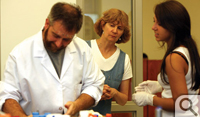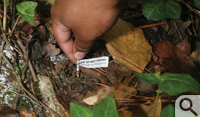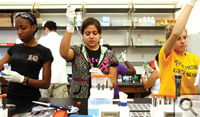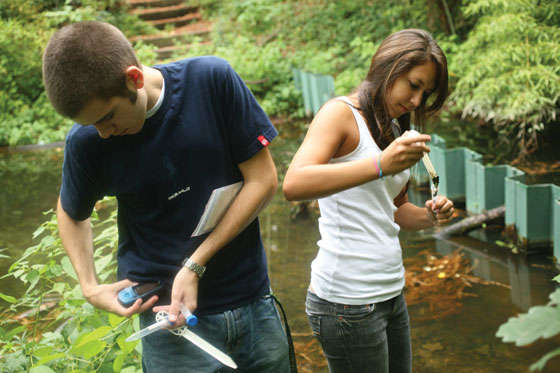Discovery of a new bacteriophage means Crim Dell isn't just for photos anymore
 It's a new form of life. It was discovered by
a lab full of freshmen...and it came out of Crim Dell. The organism, a strain of
bacteriophage, was found in the muck at the edge of Crim Dell, so the students
agreed to name it CrimD. It's undoubtedly the only new form of life to be
discovered at a campus landmark.
It's a new form of life. It was discovered by
a lab full of freshmen...and it came out of Crim Dell. The organism, a strain of
bacteriophage, was found in the muck at the edge of Crim Dell, so the students
agreed to name it CrimD. It's undoubtedly the only new form of life to be
discovered at a campus landmark.
The discovery was part of a project sponsored by the Science Education Alliance of the Howard Hughes Medical Institute. The HHMI initiative organized freshmen at 12 select colleges into two-semester research courses on the genetics of bacteriophages-or just plain phages-which are viruses that infect bacteria. The lead scientists in this research-oriented lab are Margaret Saha, Mark Forsyth and Kurt Williamson, all faculty in the biology department.
Bacteriophages are one of the hottest topics in biomedical and clinical research circles. These bacteria-attacking viruses show immense potential as alternatives to antibiotics.
"This sort of discovery could lead to possible therapies," Saha said, "particularly for tuberculosis."
It gets even better
 There's even more to the CrimD discovery. As the phage lab
begins to examine individual genes of CrimD, the participants are finding genes
that have never been found before in any virus.
There's even more to the CrimD discovery. As the phage lab
begins to examine individual genes of CrimD, the participants are finding genes
that have never been found before in any virus.
"Some of these genes are clearly much more closely related to bacterial genes than viral genes," Forsyth said. "This has led to some wonderful student hypotheses on the acquisition of host genes during the infectious process. Finding new genes in a genome this small really underscores a major point of a study like this-the genetic diversity that exists in the world surrounding us must be unfathomable. It's hard to imagine how many novel genes must be out there just waiting to be examined."
It all began in the dirt and mud near Crim Dell, just a stone's throw from the new Integrated Science Center. The students collected soil samples in the fall semester of 2008. Then, they walked back to the ISC to execute state-of-the-art lab techniques to isolate phages and prepare the phage DNA for sequencing-or genetic blueprinting-at Los Alamos National Laboratory.
Preliminary results from Los Alamos indicated that CrimD was a novel virus strain, previously unrecorded-but nobody could be sure. Forsyth said in January that the Los Alamos findings were "what's known as a draft." He explained that the draft contained all the units of the CrimD genome in three contiguous parts. An organism's genome contains the order in which the four building blocks of DNA-adenine, thymine, cytosine and guanine-are arranged in couplets known as base pairs, which make up the rungs of the spiral DNA ladder.
CrimD, with 59,798 base pairs, has a smallgenome. By comparison, Forsyth said the specific bacterium that CrimD infects has four million base pairs. The human genome consists of some three billion base pairs.
Filling in the genomic gaps
As the second semester started, the lab began using a number of sophisticated bioinformatics techniques to verify their discovery, filling in gaps of the Los Alamos sequencing, and examining CrimD's individual genes.
"One of the first things the students did was to analyze the data to identify weak spots," Williamson said. "In other words, there are points in this genome that have been sequenced a fewer number of times. Typically you want ‘8x coverage,' so each region of the genome is sequenced eight times and at least seven of those eight times need to agree."
The students used various techniques to get the CrimD genome in proper order and to address CrimD's weak spots, segments of 300 to 400 base pairs that didn't make the 8x cut at Los Alamos. The weak segments were examined using techniques such as the polymerasechain reaction, a DNA amplification tool common in molecular biology labs. All members of the phage seminar learned to use state-of-the-art bioinformatics software supplied through HHMI to process the CrimD genome in silico.
"There's in vivo and in vitro, which everybody knows," Saha explained. "In silico is becoming much more commonly used to describe things done on a silicon chip in a computer, rather than at the lab bench." Saha said that the sheer amount of data in even small virus-sized genomes such as CrimD make in silico bioinformatics techniques necessary in today's research labs.
"You absolutely need computer computational power to analyze and make sense of these hundreds of thousands of bases and how they fit together or don't fit together to make up proteins and form genes," she said. "This can't be done easily by the human mind, but the computer programs make all the possible combinations and come up with the best series of alignments. This happens in microseconds. Then, of course, we have to curate that and look at it to make sure it makes biological sense." arch, the phage lab was able to establish CrimD's singular pedigree, although no one realized the particular point at which "looking good" had solidified into a certainty.
Looking (in vain) for eureka
 "The problem with science is that there's rarely this
‘eureka' moment," Saha said. "It's gradual. By the time you get to what should
be your eureka, you realize that there was no one moment where you don't know,
then one where you do know."
"The problem with science is that there's rarely this
‘eureka' moment," Saha said. "It's gradual. By the time you get to what should
be your eureka, you realize that there was no one moment where you don't know,
then one where you do know."
Even if the scientists can't always recognize the eureka moment, they do know that they have passed it.
"Oh, it's a new virus all right," Forsyth said. "In fact, it is not falling into any of the known clusters of the viruses that infect this species of bacterium."
In late March, the phage lab hosted a gathering of other freshman phage labs, which included a visit from Graham Hatfull of the University of Pittsburgh, HHMI's lead scientist on the project, and his staff. Hatfull's people took an immediate interest in the William & Mary phage.
"CrimD," one of them said, "is cool!" 















